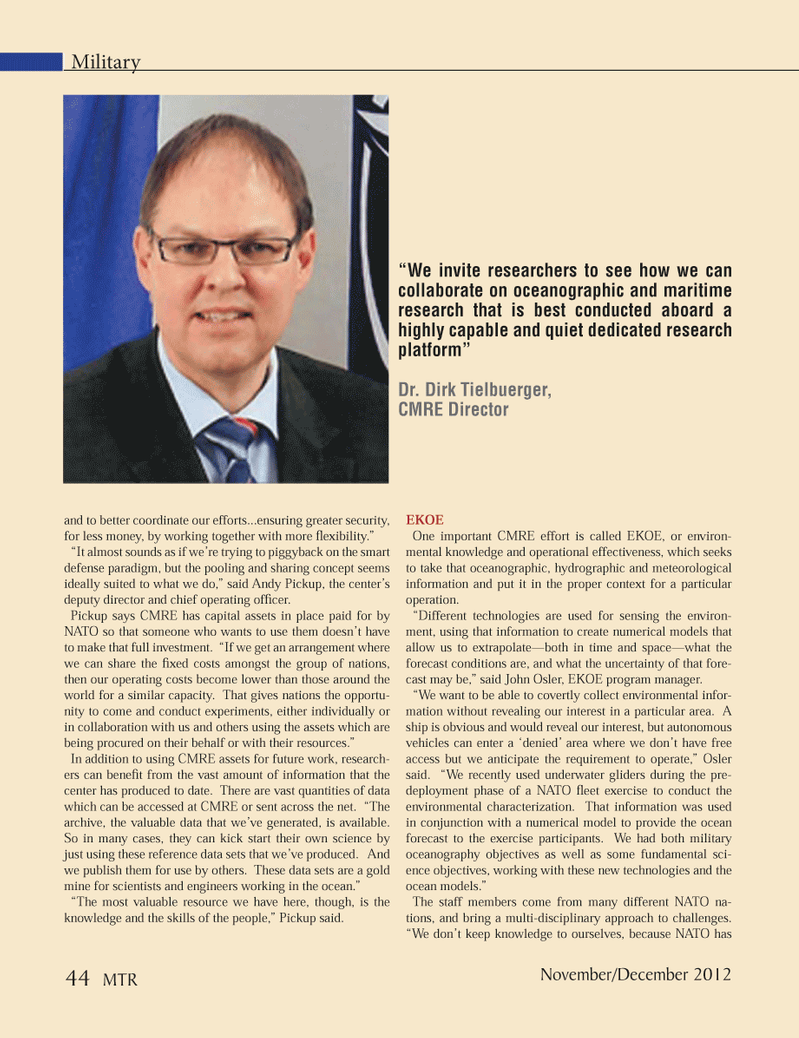
Page 44: of Marine Technology Magazine (November 2012)
Fresh Water Monitoring & Sensors
Read this page in Pdf, Flash or Html5 edition of November 2012 Marine Technology Magazine
and to better coordinate our efforts...ensuring greater security, for less money, by working together with more ß exibility.Ó ÒIt almost sounds as if weÕre trying to piggyback on the smart defense paradigm, but the pooling and sharing concept seems ideally suited to what we do,Ó said Andy Pickup, the centerÕs deputy director and chief operating ofÞ cer. Pickup says CMRE has capital assets in place paid for by NATO so that someone who wants to use them doesnÕt have to make that full investment. ÒIf we get an arrangement where we can share the Þ xed costs amongst the group of nations, then our operating costs become lower than those around the world for a similar capacity. That gives nations the opportu- nity to come and conduct experiments, either individually or in collaboration with us and others using the assets which are being procured on their behalf or with their resources.Ó In addition to using CMRE assets for future work, research- ers can beneÞ t from the vast amount of information that the center has produced to date. There are vast quantities of data which can be accessed at CMRE or sent across the net. ÒThe archive, the valuable data that weÕve generated, is available. So in many cases, they can kick start their own science by just using these reference data sets that weÕve produced. And we publish them for use by others. These data sets are a gold mine for scientists and engineers working in the ocean.Ó ÒThe most valuable resource we have here, though, is the knowledge and the skills of the people,Ó Pickup said. EKOE One important CMRE effort is called EKOE, or environ- mental knowledge and operational effectiveness, which seeks to take that oceanographic, hydrographic and meteorological information and put it in the proper context for a particular operation. ÒDifferent technologies are used for sensing the environ- ment, using that information to create numerical models that allow us to extrapolateÑboth in time and spaceÑwhat the forecast conditions are, and what the uncertainty of that fore-cast may be,Ó said John Osler, EKOE program manager. ÒWe want to be able to covertly collect environmental infor- mation without revealing our interest in a particular area. A ship is obvious and would reveal our interest, but autonomous vehicles can enter a ÔdeniedÕ area where we donÕt have free access but we anticipate the requirement to operate,Ó Osler said. ÒWe recently used underwater gliders during the pre- deployment phase of a NATO ß eet exercise to conduct the environmental characterization. That information was used in conjunction with a numerical model to provide the ocean forecast to the exercise participants. We had both military oceanography objectives as well as some fundamental sci- ence objectives, working with these new technologies and the ocean models.Ó The staff members come from many different NATO na- tions, and bring a multi-disciplinary approach to challenges. ÒWe donÕt keep knowledge to ourselves, because NATO has Military ?We invite researchers to see how we can collaborate on oceanographic and maritime research that is best conducted aboard a highly capable and quiet dedicated research platform? Dr. Dirk Tielbuerger, CMRE Director 44 MTRNovember/December 2012MTR #9 (34-49).indd 44MTR #9 (34-49).indd 4412/3/2012 11:33:35 AM12/3/2012 11:33:35 AM

 43
43

 45
45
